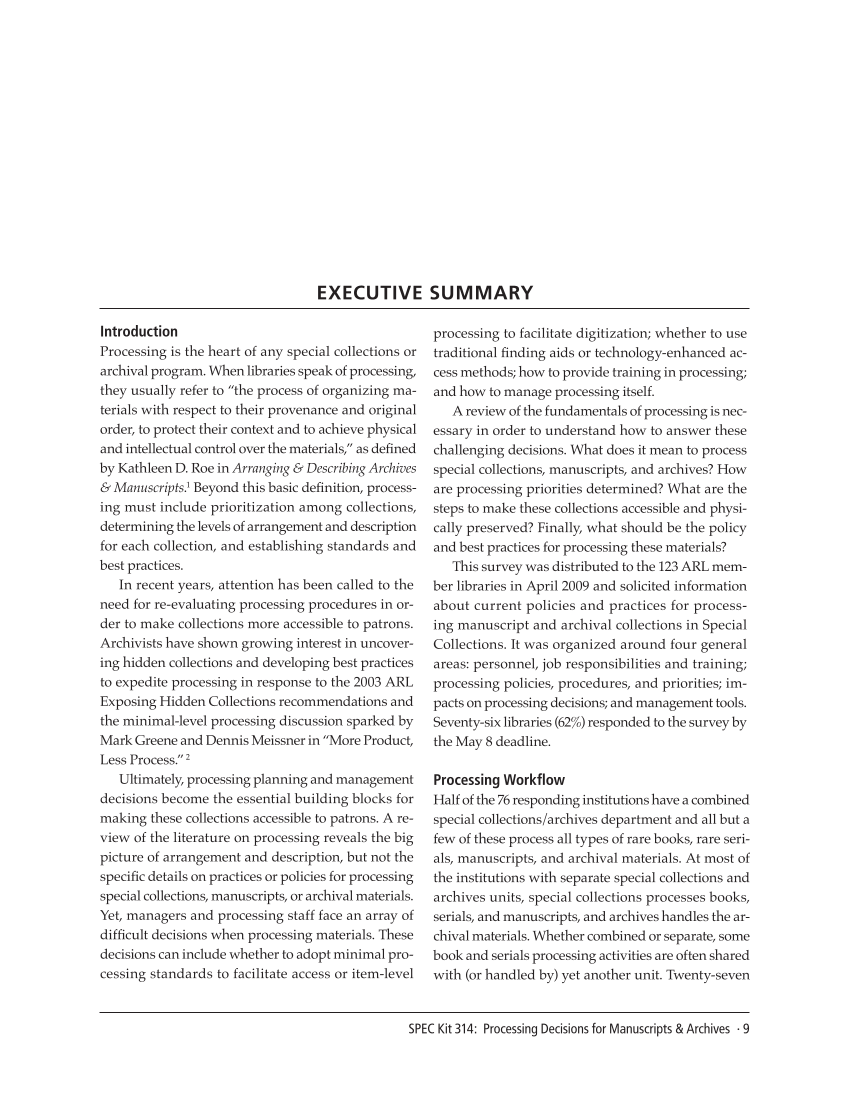SPEC Kit 314: Processing Decisions for Manuscripts &Archives · 9
Executive Summary
Introduction
Processing is the heart of any special collections or
archival program. When libraries speak of processing,
they usually refer to “the process of organizing ma-
terials with respect to their provenance and original
order, to protect their context and to achieve physical
and intellectual control over the materials,” as defined
by Kathleen D. Roe in Arranging &Describing Archives
&Manuscripts.1 Beyond this basic definition, process-
ing must include prioritization among collections,
determining the levels of arrangement and description
for each collection, and establishing standards and
best practices.
In recent years, attention has been called to the
need for re-evaluating processing procedures in or-
der to make collections more accessible to patrons.
Archivists have shown growing interest in uncover-
ing hidden collections and developing best practices
to expedite processing in response to the 2003 ARL
Exposing Hidden Collections recommendations and
the minimal-level processing discussion sparked by
Mark Greene and Dennis Meissner in “More Product,
Less Process.” 2
Ultimately, processing planning and management
decisions become the essential building blocks for
making these collections accessible to patrons. A re-
view of the literature on processing reveals the big
picture of arrangement and description, but not the
specific details on practices or policies for processing
special collections, manuscripts, or archival materials.
Yet, managers and processing staff face an array of
difficult decisions when processing materials. These
decisions can include whether to adopt minimal pro-
cessing standards to facilitate access or item-level
processing to facilitate digitization whether to use
traditional finding aids or technology-enhanced ac-
cess methods how to provide training in processing
and how to manage processing itself.
A review of the fundamentals of processing is nec-
essary in order to understand how to answer these
challenging decisions. What does it mean to process
special collections, manuscripts, and archives? How
are processing priorities determined? What are the
steps to make these collections accessible and physi-
cally preserved? Finally, what should be the policy
and best practices for processing these materials?
This survey was distributed to the 123 ARL mem-
ber libraries in April 2009 and solicited information
about current policies and practices for process-
ing manuscript and archival collections in Special
Collections. It was organized around four general
areas: personnel, job responsibilities and training
processing policies, procedures, and priorities im-
pacts on processing decisions and management tools.
Seventy-six libraries (62%) responded to the survey by
the May 8 deadline.
Processing Workflow
Half of the 76 responding institutions have a combined
special collections/archives department and all but a
few of these process all types of rare books, rare seri-
als, manuscripts, and archival materials. At most of
the institutions with separate special collections and
archives units, special collections processes books,
serials, and manuscripts, and archives handles the ar-
chival materials. Whether combined or separate, some
book and serials processing activities are often shared
with (or handled by) yet another unit. Twenty-seven
Executive Summary
Introduction
Processing is the heart of any special collections or
archival program. When libraries speak of processing,
they usually refer to “the process of organizing ma-
terials with respect to their provenance and original
order, to protect their context and to achieve physical
and intellectual control over the materials,” as defined
by Kathleen D. Roe in Arranging &Describing Archives
&Manuscripts.1 Beyond this basic definition, process-
ing must include prioritization among collections,
determining the levels of arrangement and description
for each collection, and establishing standards and
best practices.
In recent years, attention has been called to the
need for re-evaluating processing procedures in or-
der to make collections more accessible to patrons.
Archivists have shown growing interest in uncover-
ing hidden collections and developing best practices
to expedite processing in response to the 2003 ARL
Exposing Hidden Collections recommendations and
the minimal-level processing discussion sparked by
Mark Greene and Dennis Meissner in “More Product,
Less Process.” 2
Ultimately, processing planning and management
decisions become the essential building blocks for
making these collections accessible to patrons. A re-
view of the literature on processing reveals the big
picture of arrangement and description, but not the
specific details on practices or policies for processing
special collections, manuscripts, or archival materials.
Yet, managers and processing staff face an array of
difficult decisions when processing materials. These
decisions can include whether to adopt minimal pro-
cessing standards to facilitate access or item-level
processing to facilitate digitization whether to use
traditional finding aids or technology-enhanced ac-
cess methods how to provide training in processing
and how to manage processing itself.
A review of the fundamentals of processing is nec-
essary in order to understand how to answer these
challenging decisions. What does it mean to process
special collections, manuscripts, and archives? How
are processing priorities determined? What are the
steps to make these collections accessible and physi-
cally preserved? Finally, what should be the policy
and best practices for processing these materials?
This survey was distributed to the 123 ARL mem-
ber libraries in April 2009 and solicited information
about current policies and practices for process-
ing manuscript and archival collections in Special
Collections. It was organized around four general
areas: personnel, job responsibilities and training
processing policies, procedures, and priorities im-
pacts on processing decisions and management tools.
Seventy-six libraries (62%) responded to the survey by
the May 8 deadline.
Processing Workflow
Half of the 76 responding institutions have a combined
special collections/archives department and all but a
few of these process all types of rare books, rare seri-
als, manuscripts, and archival materials. At most of
the institutions with separate special collections and
archives units, special collections processes books,
serials, and manuscripts, and archives handles the ar-
chival materials. Whether combined or separate, some
book and serials processing activities are often shared
with (or handled by) yet another unit. Twenty-seven










































































































































































